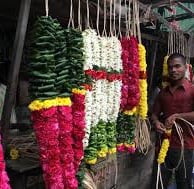CALL/Whatsapp: +91 6304795901 or Email us at contact@wanderwise.me
KAPALEESHWARAR TEMPLE CHENNAI
KAPALEESHWARAR TEMPLE CHENNAI: Step into Chennai’s spiritual heartbeat—where 1,300 years of history meet breath taking Dravidian architecture & Chennai’s soul come together in one breath taking moment
5/10/202523 min read
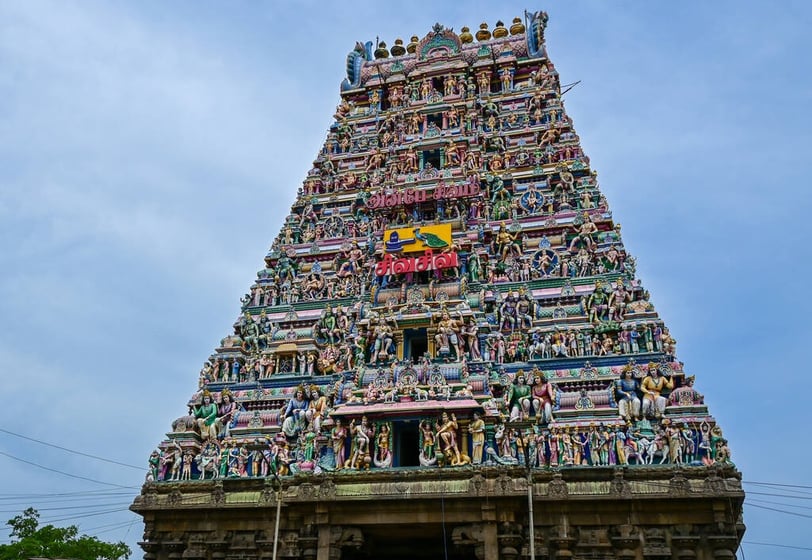

INTRODUCTION
Ever wanted to stand in a place where 1,300 years of devotion, Dravidian architecture, and Chennai’s soul come together in one breath taking moment?
It you are planning a trip to South India or there on a weekend during your business trip or just curious about this temple, what is in a visit to Kapaleshwara temple for you? Start by getting acquainted with this iconic temple.
Maybe you're planning a trip to South India. Or maybe you’re a business traveller in Chennai for the weekend, with a few free hours to spare. Either way, Kapaleshwara temple isn’t just another stop on your itinerary—it’s a must-see that captures the very essence of Chennai.
Nestled in the heart of Mylapore, one of Chennai’s oldest and most colourful neighbourhoods, this 7th-century temple dedicated to Lord Shiva offers more than just a spiritual experience—it’s a cultural immersion. While the temple's gopuram towers high above the city, with its vivid sculptures and intricate carvings, it’s the surrounding hustle and bustle that makes this temple truly unforgettable.
For the business traveller looking to add a touch of local flavour to their weekend, Kapaleshwara temple offers the perfect mix of ancient spirituality and vibrant street life. Around the temple, vibrant vendors line the streets, selling everything from fragrant jasmine flowers to intricate brass idols and colourful sarees. The energy here is infectious—and it's a photographer’s paradise. From the temple's majestic architecture to the lively market scenes, you’ll find endless photo opportunities that capture the heart of Chennai.
Why visit? Because, in Chennai, time moves fast, but in this temple, it stands still. Between quick meetings or a leisurely weekend stroll, take a moment to step into a world where history, culture, and everyday life intersect in the most captivating way. Whether you're looking for a place to unwind or a piece of Chennai’s soul to take home in a photo, Kapaleshwara Temple has something for everyone.
And here’s the best part: most visitors miss the little gems—the hidden shrine tucked away behind a pillar, the stories whispered by the temple priests, or the quiet moments of devotion that unfold in the temple’s calm corners. So, if you're in Chennai for a few days, make sure this temple is at the top of your list.
Ready to explore one of Chennai’s true treasures? Let’s step into Kapaleshwara Temple, where each corner tells a story, and the city's vibrancy dances through every step.
A NOTE ON READING MY BLOG
Considering the wonderfully diverse mix of visitors these temples attract—from Chennai locals on their daily rounds to international travellers experiencing their first South Indian shrine—I’ve tried to pack in as much essential information as possible. This blog aims to be both a practical guide and a cultural companion, blending historical context, architectural insights, spiritual nuances, and everyday observations.
I’ve made a conscious effort to strike a balance between catering to domestic readers who may already be familiar with many of the rituals and traditions, and international visitors who may be encountering them for the first time. For instance, some practices—like entering the inner sanctum (Garbhagriha)—are reserved for Hindus only, which can come as a surprise to some foreign visitors. I’ve flagged such moments to help you navigate with awareness and respect, without feeling lost or awkward.
That said, feel free to cherry-pick the parts of this blog that resonate most with you. Whether you're here for the architecture, the photography, the spiritual atmosphere, or just a great cultural story, there's something in these temples for everyone. If the whole post doesn’t hold your attention, no worries—dip into what interests you most, and skip the rest. After all, exploring a temple should feel like a discovery, not a checklist.
LOCATION,TRAVEL TIPS & TIMINGS
Reaching the Mylapore temple depends on your hotel's location. However, since most major hotels are within a 7–10 kilometre radius, it typically takes around 30–40 minutes to get there, depending on traffic conditions. On super traffic-ky days, it will take longer but don’t worry—you won’t be bored. You’ll have plenty of time in the vehicle to make friends with the driver, learn a few Tamil phrases, hear stories about his family (Drivers expect reciprocation from you. They want to hear your family stories too. Otherwise they will stop talking. One way traffic kills the thrills for the drivers you see…), and possibly contemplate life’s deeper meaning at the next signal. You might even find yourself realizing that the potholes and traffic back home aren’t so bad after all… and that maybe, just maybe, there's no need to curse.….
If you're travelling by car or van, you can get dropped off almost right in front of the temple—it's just a short 250-metre walk from there. However, if you're part of a larger group travelling by bus, stopping directly in front of the temple isn’t always possible. There's no guarantee of parking or even a brief stop for passengers to alight. The bus driver will need to figure out a suitable spot on the go, but most buses usually park near the temple tank, which is about a kilometre away from the temple.
So yes, that means a bonus one-kilometre walk — consider it your warm-up for the spiritual journey ahead… or a surprise cardio session you didn’t sign up for….. Come on, be a sport…...
Timings:
6.00 am to 12.30 pm, 4.00 pm to 8.00 pm. 6.00 am to 10.00 pm (On function and ceremony days)
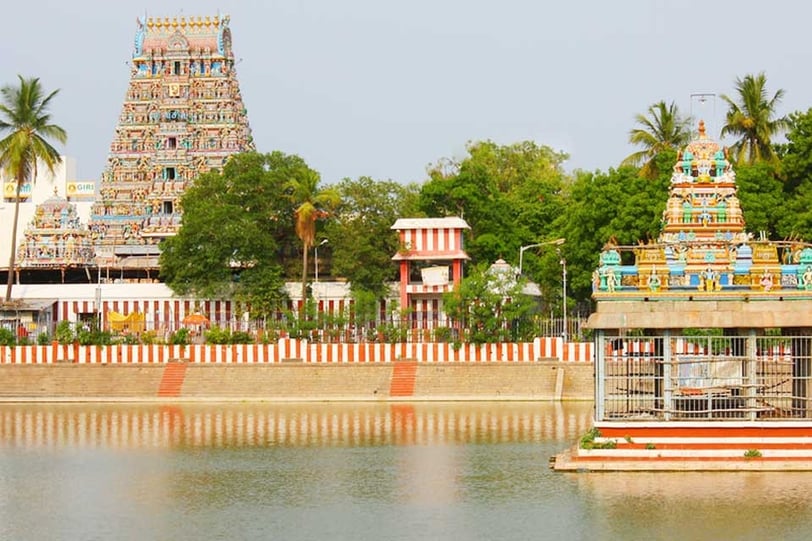

PARKING: WHERE TO LEAVE YOUR VEHICLE
If you're self-driving, there's ample paid parking available for cars and vans right in front of the temple—basically, prime real estate for your beloved vehicle. However, on crowded days (read: weekends, festivals, or any day ending in ‘-day’), this lot can fill up faster than a Ninja’s lighting speed kick. In that case, you'll need to circle the perimeter road like a hopeful devotee on a pilgrimage for parking, until you spot a divine patch of free space…...
If you're on a guided tour with a driver, it’s even simpler—just disembark in front of the temple (don’t forget to take the driver’s phone number), and once you're done, give them a call. The driver will handle the parking logistics – hopefully….
ETIQUETTE: FOOT WEAR & DRESS CODE
As you walk towards the temple, look to the left of the gopuram (that towering temple entrance) and you’ll spot the manned shoe stand kiosk—this is where your footwear goes for a brief meditation while you explore the divine….….. Shoes, slippers, sandals, Crocs—they all stop here.
If you're not too keen on going barefoot, socks are totally fine. Just remember, by the time you’re done walking around, your socks might look like they’ve had a spiritual wandering of their own—complete with mud, dust, and possibly mysterious temple floor stains. So, bring an extra pair of socks… unless you want your feet to carry the blessings home……
Dress code: Long trousers that cover the ankles and no sleeveless tops are expected. In short—dress modestly, please. You might spot people wandering in with shorts and T-shirts, but temple rules tend to change faster than a monsoon cloud over Chennai. It’s always safer (and more respectful) to err on the side of tradition.
HISTORY, ARCHITECTURE & CULTURE
This was originally built by the Pallavas in the 7th century. The old temple was destroyed by the Portuguese. Present structure as we see now was built by the Vijay Nagar dynasty in the 16th century in Dravidian temple style architecture.
Nestled amidst the lively chaos of shops and street vendors, this temple in Mylapore—the land of peacocks—is a timeless reminder of Chennai’s (formerly Madras) rich spiritual and architectural heritage. Before the present structure was built in the 16th century by the Vijayanagara dynasty, there was an older version of this temple. That one, as local lore (and some historians) say, was destroyed by the Portuguese during their little colonial adventure in these parts.
But that’s enough history for now—I promise not to turn this into a lecture. Just know that this temple has seen empires rise and fall, but the devotion here? Rock solid through the centuries.
Legend has it that Lord Shiva appeared here as a peacock to bless his consort Parvati, who was doing penance under a tree. Yes, you read that right—a divine peacock. Even the gods - particularly the gods - like dramatic entrances. Don’t they?...... Why not?
You’ll hear countless legendary tales—each one depending on who’s telling the story! Sometimes you’ll catch a North vs South India debate about how Ganesha ended up with an elephant head—like a mythological courtroom drama, with both sides convinced their version would win an Oscar…..
There isn’t one “official” scripture that settles the story once and for all—so depending on where you are and who your guide is, you’ll hear different versions of these legendary stories – all rich in its own way. I suspect many guides just stick to the story they learned back when they were practicing their language skills. They have rehearsed it so many times and now they’ve told it so many times they’re basically married to it. No turning back! People pick the legend that resonates with them—and who’s to say which one’s correct? There’s no divine fact-checker handing out gold stars for accuracy right? Exactly — why not multiple versions? After all, we’re talking about mythology, not a scientific journal. Who is to certify which one is correct?
This is one time that even if you're a die-hard atheist, where the phrase “God only knows” feels incredibly accurate…..
It’s kind of like watching Al Jazeera, CNN, BBC, and Fox News all report the same event—you’d swear they were talking about four completely different universes.
Anyway, my personal favourite legend connected to this temple is this: Goddess Parvati was once so mesmerized by the graceful dance of a peacock that she got distracted—right in the middle of one of Lord Shiva’s cosmic-level discourses. Now, you really don’t want to zone out when Shiva’s dropping universal truths. As punishment, she was cursed to be born as a peahen, right here at this spot.
But even in bird form, goddess Parvathi remembered who she truly was. She worshipped Shiva here, seeking redemption. Moved by her devotion and penance, Shiva restored her divine form and welcomed her back as his consort. A full-circle, cosmic love story—feathers and all…..
Before we delve further: Shiva is called Kapaleshwara (Lord of the mind) & Parvathi is known as Karpagambal (the divine wish-fulfilling mother)
Note: In the following sections, I offer a “Virtual Walkthrough of the Temple, in Words and Images” —a vivid, step-by-step walkthrough that reveals its many facets in words. If you prefer to experience the temple first hand and let its beauty unfold naturally during your visit, you may wish to skip ahead. For your convenience, I’ve enclosed the virtual tour within red markers.
The Gopuram
As you step into the temple, you're greeted by a towering, truncated trapezium-shaped portal called the gopuram—also charmingly nicknamed the “cow’s entrance.”
It’s not just decoration—it’s storytelling in stone. The gopuram is alive with tales: divine weddings, cosmic battles, mystics deep in meditation, demons doing... well, demon things.
This majestic gateway is stacked with multiple tiers and packed with figures of gods, goddesses, and celestial beings—a divine carnival of caravanserai built in lime stucco – so wonderfully painted with every color imaginable in the universe not in a chaotic cacophony but in a divine harmony – each element flowing into the next like a rhythmic visual hymn on stone.


Ganesh Sannidhi
After you cross the portal, the first thing you find is the Ganesh Sannidhi (elephant-headed god’s shrine). He is the divine bouncer expecting you to behave. Without his grace, you’re not getting ahead—not in the temple, not in life. So, the first offer of respect is to him. You seek his blessings for removal of obstacles from your path and to Open doors for he is the ultimate gatekeeper to the room that guards divine secrets.
He cannot be bribed but he doesn’t mind your offerings of coconuts, bananas and other savouries through the priest of course – so long as they are offered with love.
Ganesha is all knowing. He knows what’s in your heart and also what's in your snack bag too…
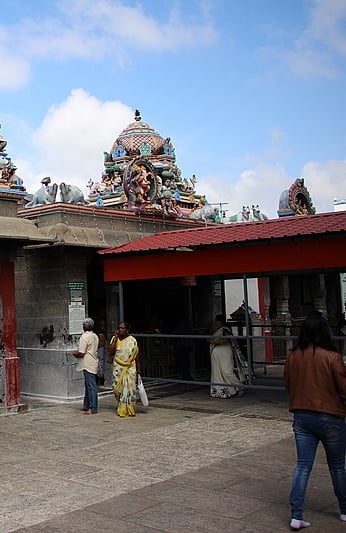

The circumambulation
In a Hindu temple, movement matters. When you walk around the sanctum, you always go clockwise—this ritual walk is called pradakshina. Why clockwise? Because you keep the deity on your right side, which is considered the side of honour and reverence. But there’s more: this way, your heart—symbolically and physically—is always closer to the deity. It’s like saying, “I'm walking with devotion, not just my feet.” Think of it as spiritual GPS, set to heart-first mode. You don’t race around—this isn’t a cardio session. It’s slow, mindful, and intentional. One step at a time, as if you're wrapping your prayers around the shrine like a soft garland of footsteps.
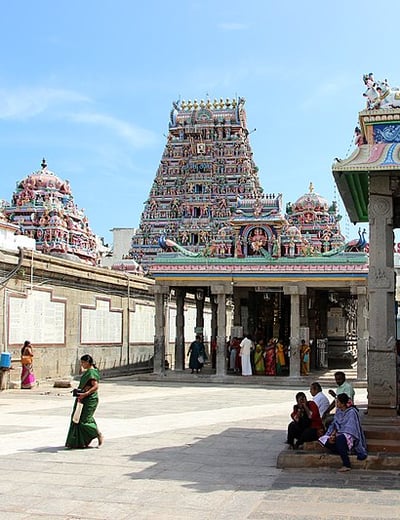

The coconut-breaking zone
So, as you take a few steps that’s where you find the coconut-breaking zone (check the place with pointed arrow in the picture below) covered with a stainless steel circular wall, not for aesthetics, but as a protective measure to stop splinters from flying because when devotees get down to smashing coconuts, they do it with the intensity of someone trying to split open not just the shell, but possibly the very ground beneath it. Just opposite the coconut-breaking zone—like a perfectly balanced counterpoint to all that smashing energy—is the temple kitchen. Think of it as a sacred soup kitchen, but with way more spices and divine intention. This is where the daily anna dhanam (free meal offering) is prepared, feeding hundreds of devotees every single day. If you happen to be there at just the right time in the morning, you’ll catch the heavenly aroma of simmering sambar, fresh rice, and temple-style vegetables drifting through the air. It’s the kind of smell that doesn’t just tease your nose—it goes straight to your soul. And yes, it will make you feel hungry again, even if you had just had a hearty buffet breakfast an hour ago.
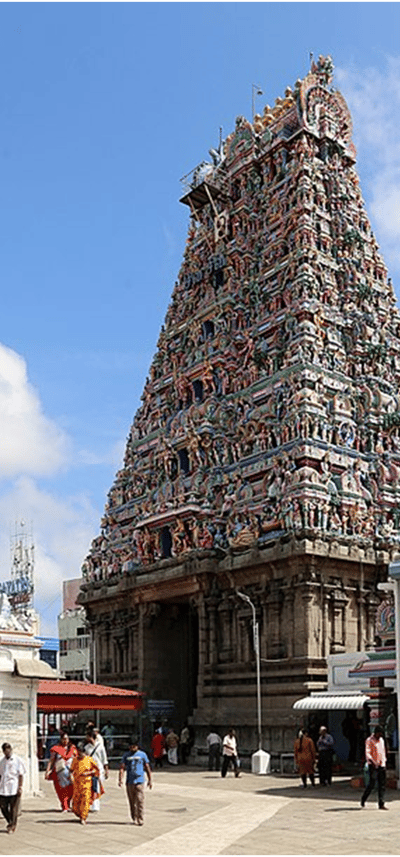

The Mandapam
As you continue along your path, you’ll come across the modern mandapam to your right side —a pillared hall that blends the traditional with the functional. Unlike the ancient stone-carved ones filled with dancing apsaras and celestial stories, this one’s more down-to-earth. Think practical elegance, where form follows function.
It serves as a venue for serving food, hosting weddings, conducting rituals, and sometimes just giving tired devotees a shady place to sit and catch their breath. On some days, it's bustling with people and the clink of steel plates; on others, it's echoing with mantras and the slightly chaotic joy of a temple wedding.
Divine drama, sacred snacks, and maybe a bit of gossip—this mandapam sees it all.
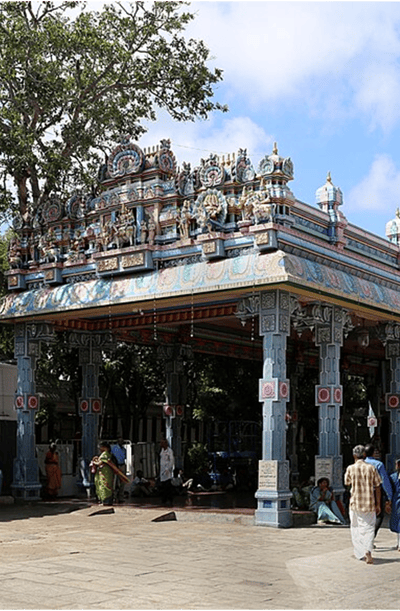

The Murugan shrine
On the right side of the mandapam you’ll find the shrine dedicated to Lord Murugan—the dashing warrior son of Shiva, and the younger (and often more flamboyant) brother of Ganesha.
If Ganesha is the calm, wise gatekeeper, Murugan is the valiant, sharp-eyed commander with a spear (vel) in hand and a peacock by his side. He’s the family’s action hero—beloved in Tamil culture, worshipped with deep devotion, especially during festivals like Skanda Shasti. His shrine often radiates a different energy: youthful, fiery, and focused.
Go a little further along the path, and you’ll realize you’ve almost done a 180-degree loop around the temple. And right at this turning point—almost like the spiritual climax of your circumambulation—you arrive at the heart of the temple: the shrines of Lord Shivaand Goddess Parvathi.
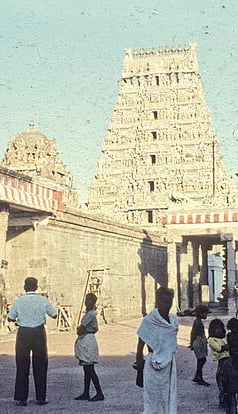

The Dwaja Sthambam
Just outside the main shrines of Shiva and Parvathi, you’ll spot the Dwaja Sthambam (or Kodi Maram, as it’s called in Tamil)—the flag mast of the temple. Back in the day, this was more than just an ornamental pole. It was the temple’s version of a notification board—different coloured flags were hoisted here to signal upcoming rituals, festivals, or ceremonies. Think of it as ancient divine event management.
Today, it stands tall and dignified—a towering stump of wood sheathed in gleaming brass, looking every bit regal, even if slightly underemployed. But don’t be fooled by its silence—this spot is spiritually loaded.
This is where devotees perform their final act of worship: a full prostration, arms stretched, forehead to ground. You don’t go past this point. This is the line. You've submitted your cosmic petition, asked what you had to ask, and now—no more haggling. As they say, the rest is in divine processing.
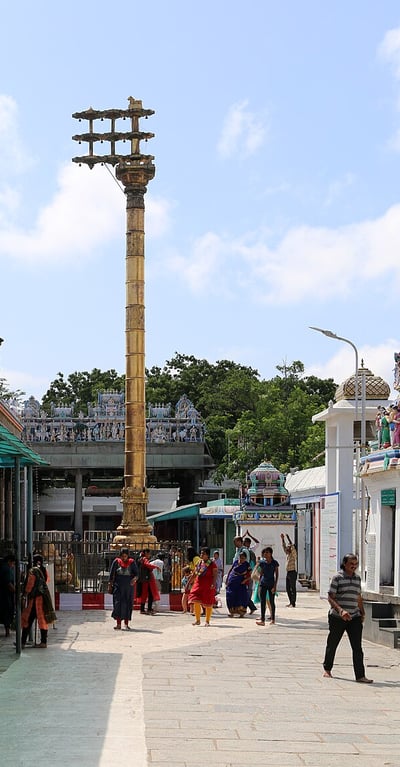

The Sacred Tank
Before you complete the final 180-degree stretch to exit the temple, there are still a few gems left to savour.
Just opposite the flag mast, there’s a backdoor and if you slip through it for a moment, you’ll be rewarded with a tranquil view of the temple’s ablution tank, or Pushkarni.
This sacred tank is no ordinary pond. Its waters are said to cleanse more than just dust and sweat—it’s symbolic purification.
The scared tree of the temple
Re-enter the temple and continue along the final stretch of your walk, and soon you’ll arrive at one of the most quietly powerful corners of the temple—the sacred wish-fulfilling tree. At first glance, it might just look like an old tree wrapped in reverence. But look closer and you'll see it’s practically bursting with human hope. There are yellow strings tied around its trunk and branches—each one knotted in prayer by unmarried women seeking a suitable groom. Some strings are new and bright, others faded and weather-worn, waiting patiently for the universe to respond. Below, you’ll find small heaps of stones, carefully stacked by people praying for the means and stability to build a home—each stone a miniature foundation of a dream. Nearby, you might spot tiny wooden cradles or even clay figures of crawling babies placed by couples hoping for a child. It’s a quiet, sacred gallery of longing and love, where faith takes the shape of everyday desires.
This is where devotion gets deeply personal—less about grandeur, more about gentle whispers to the divine.
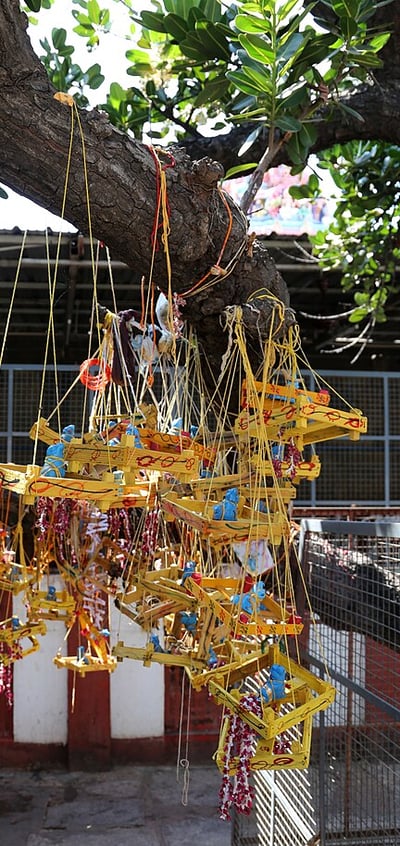

The Nava graham (the shrine of nine planets)
Alright, hang in there—just one last thing before you make your grand exit through the gopuram
Tucked into a quiet corner, often slightly off the main path, is the Navagraha shrine—the celestial command centre of the temple. These are the nine planetary deities, each busy influencing your karma, calendar, and credit score.
From your marriage prospects to your in-laws’ moods, your children’s welfare to your parents’ longevity, your mood swings to your mortgage—the fluid blueprint for your coming days is getting drafted here by the minute, one celestial alignment at a time.
Devotees walk around this shrine with a certain reverence and just a hint of anxiety—whispering requests, offering flowers or sesame seeds, trying to keep the planets pacified. Because after all the devotion and coconut carnage, you still don’t want a grumpy Saturn messing with your to-do list.
FESTIVALS & CELEBRATIONS: THE TEMPLE IN FULL SPLENDOR
If all that wasn’t enough and you really want to witness the "Next Level Energy" of this temple—like, spine-tingling chants, goose-bumps from drums, and devotion so thick you can almost breathe it in—then you must visit during one of these festival days.
Panguni Peruvizha (March–April)
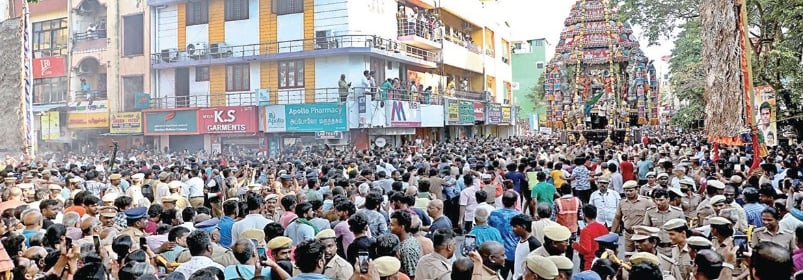

This is the crown jewel of temple festivals. A 9-day extravaganza culminating in the Ther Thiruvizha (Chariot Festival). Mylapore turns into a devotional carnival. People line the streets, pull giant wooden chariots, sing bhajans (devotional songs), and offer prayers while flower petals rain down.
Pro tip: Get there early for a safe, good view and shade!
Arupathimoovar Festival (Part of Panguni)
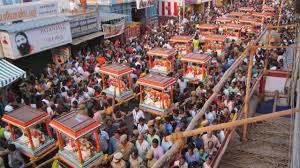

A mega-procession featuring the 63 Nayanmars—Shaivite saints whose divine devotion sparked miracles and legendary tales that still echo through Tamil history. On this day, the deities are decked out in full royal regalia and taken on a grand procession through the streets of Mylapore.
It’s not just a religious ritual—it’s a living epic. Imagine ancient history, deep devotion, and street theatre all rolled into one vibrant celebration. You don’t just watch it—you feel it.
Mahashivaratri (Feb–March) – the great night of Shiva
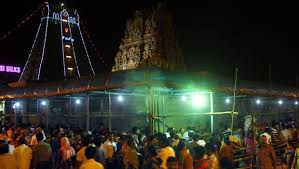

According to Hindu belief, Lord Shiva is awake 24/7 for 364 days a year—a cosmic insomniac, if you will. But even he gets one night off: the Great Night of Shiva, or Mahashivaratri.
Now here’s the twist: being the supreme god and all, if Shiva chooses to go into sleep mode… well, he may never wake up. That’s right—if Shiva dozes off, he could go into an eternal snooze. And that, as you can imagine, is not ideal for the functioning of the universe.
So, following Mahashivaratri, it’s the devotees’ divine duty to get him awake. All night long they stay up chanting, meditating, offering prayers, and performing special rituals—basically doing whatever it takes to make sure Shiva doesn't hit that cosmic snooze button permanently.
Navaratri (Sep–Oct)
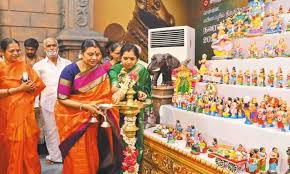

Nine nights of celebrating the divine feminine with doll festival. Goddess Karpagambal is adorned differently each day. The temple lights up, both literally and spiritually, and classical music fills the air.
Vinayagar Chaturthi (Aug–Sep)
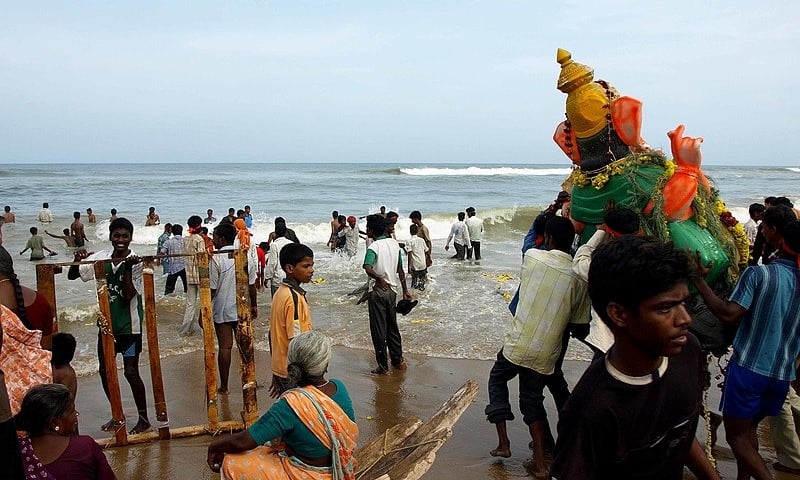

It’s Ganesha’s birthday—and the temple turns into a joyful riot of colour, music, and devotion. There’s a coconut-breaking frenzy at the entrance (because what’s a birthday without a little smashing?), special pujas, and some of the cutest clay idols of Ganesh you’ll ever see, lovingly decorated and paraded around before being immersed in the sea or river. The energy level? Joyful, earthy, and full of laughter. It’s like the most adorable divine block party, where the gods are in a celebratory mood.
Note: The temple follows the lunar calendar, so festival dates tend to shift a bit each year. If you're planning a visit, best to check the local calendar or ask around in Mylapore— someone for sure knows when the next big celebration is brewing.
Theppam festival - January–February
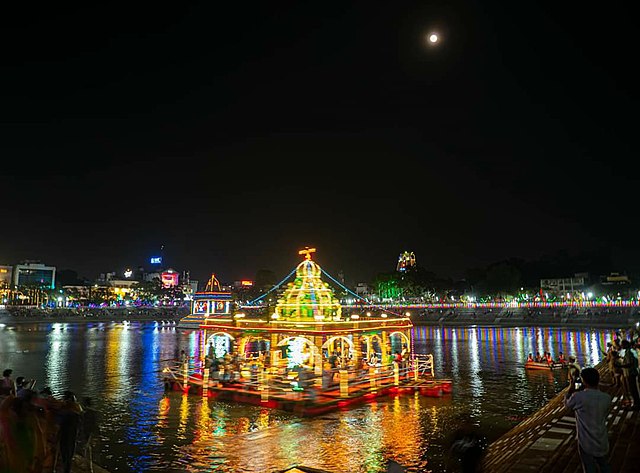

The Theppam Festival is a major attraction in Mylapore, drawing large crowds of devotees and tourists. It is part of a series of festivals at the Kapaleshwara Temple, including the Mylapore Festival held earlier in January.
The Theppam Festival at Sri Kapaleshwara Temple in Mylapore is an annual event tied to the Tamil festival of Thaipusam, which occurs on the full moon day (Pournami) in the Tamil month of Thai (January–February). As a result, the festival dates vary each year based on the lunar calendar.
PILGRIMS & SPIRITUAL VIBES: THE DEVOTEE EXPERIENCE
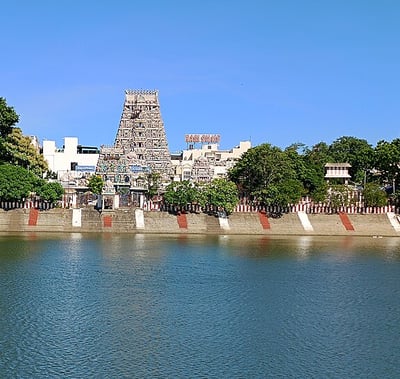

The spiritual pulse of Kapaleshwara Temple isn’t just confined to its towering gopurams or the rhythm of its rituals—it’s in the very air. Every day, pilgrims come in steady streams: some with silent prayers, others with songs on their lips, and a few just to sit and soak in the calm amidst the chaos of city life.
What makes the spiritual vibe of Kapaleshwara Temple even more layered is its quiet role in a much larger, moving tapestry of devotion—especially during the Sabarimala pilgrimage season. (Roughly mid-November to mid-January).
Sabarimala pilgrims, known for their intense 40-day fasting and spiritual discipline, often make a stop here as part of their route to Lord Ayyappa’s shrine deep in the Kerala forests. Clad in black or saffron, walking barefoot, they observe strict vows of celibacy, simplicity, and prayer during this period. During these 40 days, many of them visit sacred temples en route, seeking blessings, grounding their minds, and preparing their spirits. Kapaleshwara Temple becomes one such sacred stop—a place to bow before Lord Ganesha, the remover of obstacles, and to offer prayers at the feet of Lord Shiva and Goddess Parvathi before continuing their journey.
It’s not an official stop on the route—it’s a devotional detour that many willingly take. And in doing so, they transform the temple’s atmosphere—already spiritual—into something humbler, deeper, and more charged.
For those moments, the temple isn't just a historic monument or a local shrine—it becomes a crossroads of faith, where traditions intertwine and every step taken barefoot echoes centuries of pilgrimage.
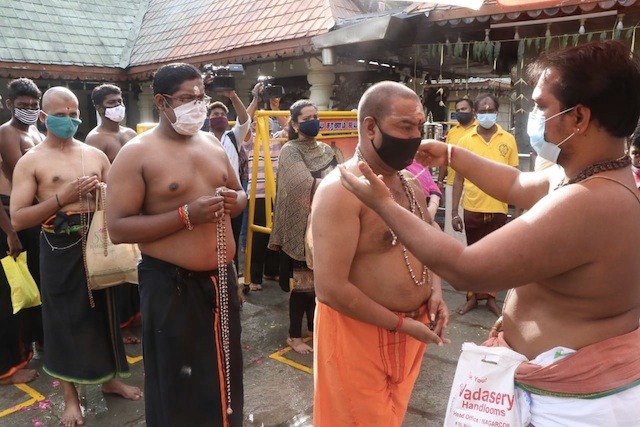

PHOTOS: WHAT’S ALLOWED, NOT, ANGLES, LIGHT & GOLDEN HOUR
While you are permitted to take pictures inside the temple with a small camera fee (most parts of the temple) you can never point your cameras to take picture of the gods inside the shrines. So by all means, capture the pillared halls, vibrant ceilings, flickering oil lamps, and maybe even a priest or two if they don’t mind—but when you step before the gods, let the camera rest, and just take it in with your eyes and your heart.
Before you even think about snapping pictures inside the temple, you're first greeted—no, invited—by the gopuram, the towering gateway that looks like a mythological skyscraper dipped in a palette of gods, demons, and celestial beings. Shooting from directly in front of the temple gopuram is an absolute classic—and it's a powerful angle for showcasing both the height and the stunning symmetry of the structure.
If you’re visiting in the morning, you’re in for a treat: the rising sun hits the gopuram head-on, lighting it up in glorious golds, pinks, and blues. It’s like the temple decided to put on its finest face just for you.
Apart from the classic front view, there’s a hidden gem of a photo spot—walk over to the opposite side of the temple tank. From there, you get a distant, postcard-perfect frame of the gopuram reflected gently in the water, especially in the early morning when the tank is still and the sky’s just waking up.
It’s the kind of shot that makes people go, “Wait, where is this?” on Instagram.
Pro tip Bring a lightweight easy-to-use camera that punches above its weight—something that can handle super pixel-rich images. A good zoom lens is your best friend here. It’ll help you capture those intricate lime-stucco sculptures—the gods mid-dance, the celestial beasts snarling, and the tiny details that often go unnoticed unless you zoom in close.
EXPLORING THE SURROUNDINGS: AROUND THE TEMPLE COMPLEX
Now that you’ve done a full 360° tour of the temple, soaked in the shrines, made your offerings, snapped your respectful photos, and maybe even tied a prayer string or two—it’s time to step back into the world of shoes.
Head over to the shoe stand near the gopuram and reclaim your humble footwear. It’s funny how that first step back into your sandals feels like returning from another world. One moment you're walking on sacred stone, the next you're adjusting your Velcro straps or sliding back into floaters like a regular earthling again. Spirituality—wrapped up, tied tight, and ready to walk on.
Wait! You’re not ready to beckon your car just yet. Sure, your temple darshan is done, and your shoes are back on, but Mylapore isn’t quite finished with you.
There’s still the buzz of the flower market, the aroma of fresh filter coffee calling you from across the street. If you’re part of a walking tour, lucky you—because the fruit and vegetable market stroll, the steaming filter coffee, and a classic South Indian breakfast are all included. It’s like a post-spiritual buffet, curated just for your senses.If not, no worries. You can mix and match your own experience—grab a quick coffee from a roadside stall, nibble on some crispy vadai, or just take a slow wander through the colorful chaos of the nearby market. There’s no fixed route after the divine one. Mylapore isn’t just a temple visit. It’s a full-body, full-soul experience.
AMENITIES & PUBLIC FACILITIES FOR VISITORS
Don’t expect sparkling clean restrooms near the temple. At best, you’ll find some moderately okay options—but most are squat toilets, and, let’s say, not for the faint-hearted. If you're looking for a cleaner, sit-down option, your best bet is to politely walk into a nearby restaurant or café. Order a coffee or snack, and you’ll be able to use the facilities there without fuss.
SHOPPING & ESSENTIALS: WHAT TO BUY AND WHERE
While you definitely need to try a filter coffee in one of the near-by cafes, after your visit to the Kapaleshwara Temple (because spiritual enlightenment pairs best with a caffeine kick), once you’ve respectfully received your shoes from where your abandoned them, prepare to be ambushed — not by divine revelations, but by an army of enthusiastic garland vendors. They're faster than temple elephants and will have a flower mala around your neck before you can say "Om"!
The flowers are so fresh — you can still see honeybees hovering about like tiny quality inspectors — you would think they plucked just seconds ago! The vendors, working with the finesse of a Formula 1 pit crew, expertly string the garlands using either cotton thread or banana fibre, depending on the weight. If the garland rivals a small anaconda in size, banana fibre it is. Structural integrity is crucial when you're crafting high-stakes floral couture.
In these same shops, alongside the fragrant garlands and flower-powered fashion, you’ll also spot shelves crammed with religious trinkets — tiny brass deities, packs of camphor, and enough Kumkum (the red powder which women - and sometimes men - apply on their forehead) to start your own temple. There are even neat stacks of sacred wood from a specific tree, pre-cut and ready to go, in case anyone suddenly feels the urge to light a homam (sacred fire) and perform a quick Puja for household peace or bonus karma points.
And then there's varati — cow dung patties mixed with straw and artfully splattered on walls, looking suspiciously like oversized rotis left out to dry. Not exactly lunch, but very much part of the tradition – when sacred fire is to be lit.
During Navaratri — the grand nine-night celebration where every home turns into a mini museum — the area transforms into doll central. You’ll find a bundle of shops proudly displaying clay dolls of gods and sages, Papier-Mâché goddesses, and the occasional slightly cross-eyed tiger that’s still charming in its own way. From mythological epics to modern-day additions (yes, there's often a cricketer or two hiding among the sages), the variety is wild. It’s like a divine talent show in terracotta.
For Indian tourists (and homesick homemakers on a mission), there are a handful of condiment shops proudly exhibiting Tamil Nadu–style masalas. These stores are a sensory overload — sacks of red chili powder, turmeric that could stain your soul, and sambar powders so aromatic they might just summon your grandmother. And hey, foreigners can dive in too — just be warned, one whiff of that rasam mix and you might develop a lifelong craving for spice-laden comfort food you didn’t even know existed. Good luck trying to recreate it back home though; somehow, it never tastes the same without the chaos, humidity, and background chorus of temple bells.
Now you can make your way to the car park — but before you summon your chariot for the next adventure, if you’ve still got some energy left (and haven’t melted into the pavement), take a right... and then another right. That’s where you’ll stumble upon the bustling vegetable and fruit market, a riot of colour, sound, and unfamiliar produce with names that sound like tongue twisters.
It’s a great place to admire exotic varieties — purple yams, drumsticks longer than your forearm, and gourds that look like they came from outer space. What I don’t fully understand, though, is why the vendors keep trying to sell tourists three kilos of okra. Like yes, I love cultural immersion… but where exactly do you think I’m storing a week’s worth of ridge gourd?
If you're a foreign tourist looking to buy a dhoti or saree for a Bollywood-themed evening back home or to attend a traditional wedding in South India, you're in luck! Many local shops around the temple sell easy-to-wear versions of traditional attire. These look like authentic wraparounds but are cleverly designed with Velcro fastenings, making them much easier to wear—no draping skills required!
That was an adventure, wasn’t it? From flower ambushes to banana fiber engineering, spice-laden nostalgia to fruit market mysteries and traditional fashion wear — you’ve officially earned your temple-town explorer badge. It is time to head back to the hotel, kick off those sandals and give your feet (and your camera) a well-deserved rest. Maybe even sip that one more filter coffee now — the spiritual kind can wait till tomorrow.
WHY JUST READ IT WHEN YOU CAN LIVE IT? COME EXPLORE WITH ME!
With over two decades of experience in curating unforgettable journeys, we specialize in organizing tours across India, Southeast Asia, and select European destinations. Let us take you beyond the guidebooks and into the heart of each place we visit. Come travel with us—your adventure begins here.

